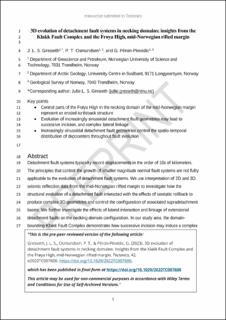| dc.contributor.author | Gresseth, Julie Linnea Sehested | |
| dc.contributor.author | Osmundsen, Per Terje | |
| dc.contributor.author | Peron, Gwenn | |
| dc.date.accessioned | 2023-03-16T09:58:35Z | |
| dc.date.available | 2023-03-16T09:58:35Z | |
| dc.date.created | 2023-03-01T11:13:07Z | |
| dc.date.issued | 2023 | |
| dc.identifier.issn | 0278-7407 | |
| dc.identifier.uri | https://hdl.handle.net/11250/3058684 | |
| dc.description.abstract | Detachment fault systems typically record displacements in the order of 10s of kilometers. The principles that control the growth of smaller magnitude normal faults are not fully applicable to the evolution of detachment fault systems. We use interpretation of 2D and 3D seismic reflection data from the mid-Norwegian rifted margin to investigate how the structural evolution of a detachment fault interacted with the effects of isostatic footwall rollback to produce complex 3D geometries and control the configuration of associated supradetachment basins. We further investigate the effects of lateral interaction and linkage of extensional detachment faults on the necking domain configuration. In our study area, the domain-bounding Klakk Fault Complex demonstrates how successive incision may induce a complex structural relief in response to faulting and fault plane folding. We interpret the previously proposed metamorphic core complex within its footwall as an extension-parallel turtleback-structure. The now eroded turtleback is flanked by a major supradetachment basin, connecting two main basin segments. We attribute footwall- and turtleback exhumation to Middle Jurassic - Early Cretaceous rifting. The study area further demonstrates how detachment fault geometries can change during rifting and lead to the formation of younger, successively incising fault splays. Lateral linkage between the original detachment fault plane and these fault splays enables displacement along a detachment fault system consisting of fault segments generated at different stages in time. Implicitly, detachment faults are complex 3D systems that change configuration during their evolution, perpetually controlling associated basin formation, footwall configuration, subsidence and uplift patterns. | en_US |
| dc.description.abstract | 3D evolution of detachment fault systems in necking domains: insights from the Klakk Fault Complex and the Frøya High, mid-Norwegian rifted margin | en_US |
| dc.language.iso | eng | en_US |
| dc.publisher | Wiley | en_US |
| dc.title | 3D evolution of detachment fault systems in necking domains: insights from the Klakk Fault Complex and the Frøya High, mid-Norwegian rifted margin | en_US |
| dc.title.alternative | 3D evolution of detachment fault systems in necking domains: insights from the Klakk Fault Complex and the Frøya High, mid-Norwegian rifted margin | en_US |
| dc.type | Journal article | en_US |
| dc.description.version | submittedVersion | en_US |
| dc.source.volume | 42 | en_US |
| dc.source.journal | Tectonics | en_US |
| dc.identifier.doi | 10.1029/2022TC007600 | |
| dc.identifier.cristin | 2130415 | |
| dc.relation.project | Norges forskningsråd: 295208 | en_US |
| cristin.ispublished | true | |
| cristin.fulltext | preprint | |
| cristin.qualitycode | 2 | |
